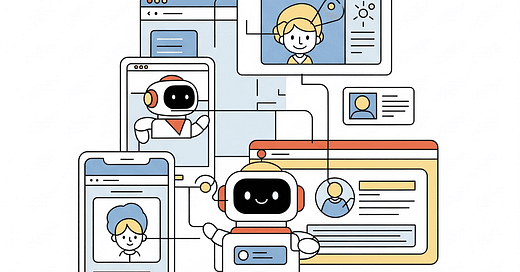Why Every App and Website Needs AI Integration from Day One
This article explores why integrating AI from the start is a must for every app and website.
Why AI Should Be a Default in New Projects
1. User Expectations Have Evolved
These days, people expect smart features right out of the box:
Intelligent search and recommendations
Chatbots or virtual assistants
Auto-complete, summarization, personalization
Voice control and natural language input
If your app or site doesn’t “think,” it instantly feels outdated. No one’s wowed by static anymore.
2. It’s a Major Competitive Edge
Apps that use AI don’t just look cool — they perform better:
Faster, smoother user experiences
Automation that cuts out boring tasks
Personalized content and offers
Real-time insights and predictions
It’s not just a “nice-to-have” anymore — AI is a game-changer.
3. It Boosts Engagement and Retention
AI keeps people coming back:
Personalized feeds (think TikTok-level addictive)
Smart notifications that actually matter
Interfaces that adapt to users in real time
On-the-spot help or guidance
This is how apps build loyalty in 2025.
Designing for an AI-First Future
1. Start by Identifying AI Opportunities
Before writing code, ask yourself:
“Where could intelligence make this faster, easier, or smarter?”
A few examples:
Building an e-commerce platform? → Add smart search, AI-driven pricing, and image-based product lookup.
Launching a learning app? → Use AI for personalized learning paths, quiz generators, and virtual tutors.
Making a blog tool? → Integrate AI-assisted writing, content summaries, and SEO help.
2. Create Modular AI Slots
Even if you're not adding AI immediately:
Write your backend clean and modular so models can be plugged in later.
Use APIs and microservices to separate AI from your core app logic (like with OpenAI, Hugging Face, or custom APIs).
This gives you flexibility without needing a full rebuild down the line.
3. Collect Data — But Do It Right
AI runs on data — but not just any data:
Set up systems that track behavior transparently and with consent.
Use that data to personalize user experiences without being creepy.
Respect privacy. Build trust.
4. Get Comfortable with Prompts and APIs
Even if you’re a frontend dev or working in no-code:
Learn how to write prompts that get good results from language models.
Understand how to make simple API calls to services like OpenAI, Gemini, Claude, or Cohere.
It’s not rocket science, but it is essential knowledge now.
A New Mindset for Builders
Old mindset:
“Maybe I’ll add AI later if I need it.”
New mindset:
“How do I make this app smart from day one?”
AI shouldn’t be an afterthought. It should be baked in from the beginning.
Real Examples of AI-Driven Features
Duolingo uses AI for personalized learning paths, adaptive quizzes, and even conversation practice with AI bots.
Facebook (Meta) leverages AI to curate your feed, detect harmful content, and power features like face recognition and ad targeting.
Twitter (X) uses AI for content moderation, recommended tweets, and smarter search.
Instagram taps into AI for everything from post recommendations and Stories filters to detecting spam and abusive behavior.
Want to use ai from ideation phase to deployment phase? here is an article for you Jinsi ya kutumia AI kuanzia ideation phase hadi deployment phase




